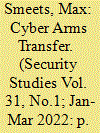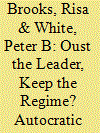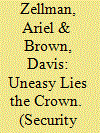|
|
|
Sort Order |
|
|
|
Items / Page
|
|
|
|
|
|
|
| Srl | Item |
| 1 |
ID:
188213


|
|
|
|
|
| Summary/Abstract |
What are the motivations and opportunities for arms transfer in the cyber realm? Although scholarship has failed to systematically address this question, having an accurate answer is crucial for understanding the operationalization of cyber commands and intelligence alliances, the functioning of the North Atlantic Treaty Organization in the twenty-first century, and the viability of cyber arms controls. First, this article introduces a new conceptual framework—the people-exploits-tools-infrastructure-organization (PETIO) framework—to understand the elements of an offensive cyber capability. Second, I explain how the incentives of cyber arms transfer differ across the different elements of the PETIO framework. Though exploits and tools can be effortlessly replicated, their transitory nature and potential for operational tracking means there is little incentive to actually transfer these assets. If any incentives exist for state-to-state transfer, it would be in facilitating other state actors to develop their own offensive capabilities—that is, by providing expertise, infrastructure, and organizational capacity to adapt and innovate—as this does not reduce the effectiveness of one’s own arsenal. Third, I argue that the incentives for transferring cyber effect capabilities are weaker compared to cyber espionage capabilities, and attribution dynamics add an additional layer of complexity to these transfer dynamics.
|
|
|
|
|
|
|
|
|
|
|
|
|
|
|
|
| 2 |
ID:
188212


|
|
|
|
|
| Summary/Abstract |
Signaling is a core element of international crisis bargaining and coercive diplomacy. To succeed in crises, a state must convey to its opponent that it possesses the capability to impose an advantageous outcome and that it is resolved to do so, while also managing the risks of unintended escalation and war. However, less studied in signaling literature is how states can use signals for the purposes of managing escalation risks or even de-escalating crises. In this article, we develop a theory of signaling in cyberspace. We argue that, although cyber operations are not particularly well suited as costly signals of resolve or capabilities in the context of coercive diplomacy, they have a distinct utility for signaling to manage escalation risks. We build a framework organized around the causal mechanisms of accommodative signaling in cyberspace and test it against a set of comparative case studies. We find that cyber operations can act as accommodative signaling under some conditions, particularly when decision makers are faced with managing tensions between simultaneously signaling to domestic audiences and adversary governments.
|
|
|
|
|
|
|
|
|
|
|
|
|
|
|
|
| 3 |
ID:
188211


|
|
|
|
|
| Summary/Abstract |
Recent scholarship has established that a majority of Americans will support the use of nuclear weapons and violate the principle of noncombatant immunity when American lives are on the line. Some scholars contend, however, that these hawkish American attitudes are an outlier and that other Western democratic publics have more fully internalized the nuclear taboo, as well as the prohibition on deliberately killing civilians. To investigate cross-national attitudes on these important norms, we conducted a survey experiment of American, British, French, and Israeli citizens. We find that American attitudes are not exceptional. Rather, Israeli respondents display the most hawkish preferences; French and American citizens are roughly equally hawkish; and the British public is consistently the least supportive of nuclear use or targeting civilians. Categorical prohibitions—against nuclear use and targeting civilians—do little to shape public opinion in these four countries. Instead, public opinion in each state follows the same consequentialist logic: a majority or near majority of respondents are willing to support using nuclear weapons when they are more effective than conventional options, but support declines when collateral civilian deaths rise. Respondents’ preferences for compatriots over foreign civilians and respondents’ retributiveness help explain individual-level variation in attitudes.
|
|
|
|
|
|
|
|
|
|
|
|
|
|
|
|
| 4 |
ID:
188215


|
|
|
|
|
| Summary/Abstract |
We present a theory for how variation in autocratic civil-military relations affects the type of coups to which autocratic leaders are vulnerable. Dictators rely on alternative strategies of control that involve tensions across two imperatives—governance and coup prevention. In a “grand bargain,” leaders cede prerogatives to the military and compromise on the governance imperative. This insulates them from regime-change coups but still renders them vulnerable to reshuffling coups that result from bargaining failures. Alternatively, political leaders may rely on “containment,” in which they marginalize the military. Although they make fewer concessions on the governance imperative, the military is more likely to oust the entire regime when the former has the opportunity to engage in a coup, not just reshuffle the leader. We evaluate this theory using within-case process tracing and paired case studies of Tunisia and Egypt, and conduct descriptive quantitative analyses to demonstrate the generalizability of our theory.
|
|
|
|
|
|
|
|
|
|
|
|
|
|
|
|
| 5 |
ID:
188214


|
|
|
|
|
| Summary/Abstract |
How can states most effectively reassure their allies? Existing studies assessing signals of commitment focus on the role of resolve in making assurances credible. This sidelines important questions about the role of capability. We argue that reassurance effectiveness is the product of both capability and resolve, and suggest that high resolve cannot offset low capability. We introduce a new typology of reassurance measures based on the interaction of military capability and resolve, and test which types of measures are most reassuring using an original survey fielded on European foreign policy experts and a case study of US and North Atlantic Treaty Organization reassurance initiatives in the Baltics. We find that high-resolve, low-capability signals such as tripwire forces in allied territory are not viewed as any more reassuring than high-capability, low-resolve signals such as forces stationed offshore. Our study casts doubt on the reassurance value of tripwires and contributes to scholarship on interstate signaling.
|
|
|
|
|
|
|
|
|
|
|
|
|
|
|
|
| 6 |
ID:
188216


|
|
|
|
|
| Summary/Abstract |
Although often argued that religion should significantly influence international conflict, the empirical record is mixed. For every recurrent interreligious conflict, there are numerous examples of sustained interreligious cooperation. Conflict also frequently mars the oft-assumed peaceful relations between shared-religion states. We argue that religion is an important intervening factor in interstate dispute militarization, especially between internally threatened rivals. In mixed-religion dyads, conflict often follows oppression of cross-border coreligionists, whereas in shared-religion dyads, conflict occurs as one side disproportionately increases its official support for that religion. In both instances, dispute militarization is primarily an effort to undercut domestic competitors, whose challenge is augmented by external threats to leaders’ religious legitimacy. We test these propositions using new, long-term data on religious demography and state-religion policy, identifying rivalries via antecedent interstate territorial disputes. The findings largely confirm our hypotheses, substantially clarifying the conditions under which religion contributes to international militarized conflict.
|
|
|
|
|
|
|
|
|
|
|
|
|
|
|
|
|
|
|
|
|